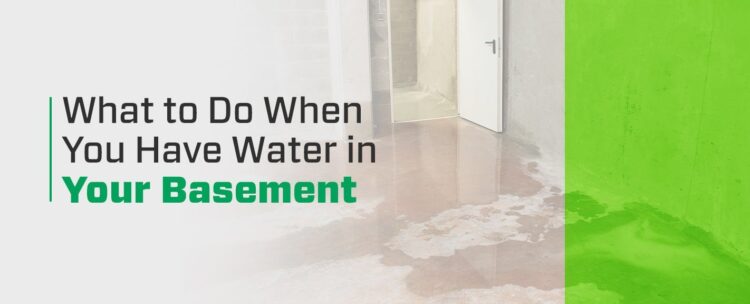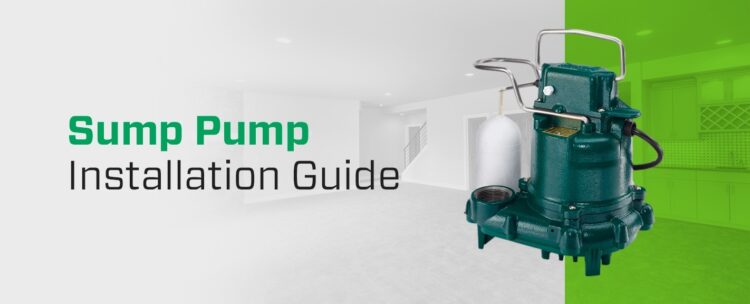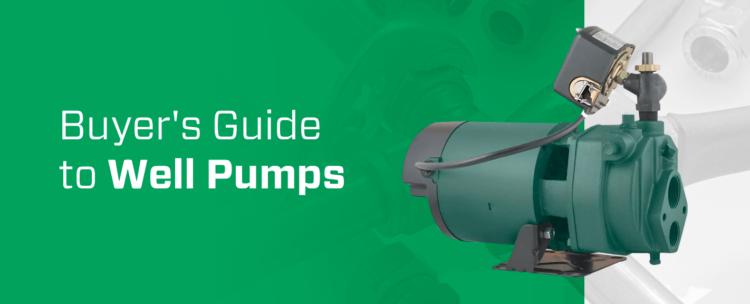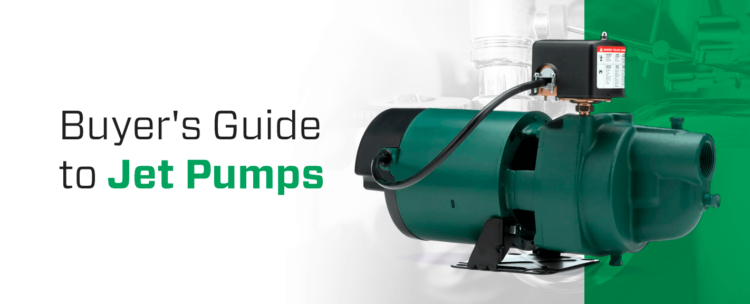
Having a home with a basement has a lot of benefits. There’s the extra living space, the cool place to escape in the hot summer months, and the appeal of having ample storage for your family’s belongings. But owning a home with a basement also means taking care to keep it dry.
According to the American Society of Home Inspectors, 60% of homes experience wet basements, typically due to heavy rains or melting snow. But basement flooding isn’t always weather-related. Sometimes, water can get into the basement through something as simple as dirty or misdirected gutters. Rising groundwater can accumulate around a home’s foundation and seep in through cracks and joints, causing the basement to take on water.
If you live in an area prone to heavy rains or you’ve had problems with basement moisture in the past, it’s crucial to have a working sump pump to prevent water from leaking into the basement and destroying your home. Even a small amount of moisture can cause a lot of damage — and cost a lot to repair. But even the best sump pump can fall short in a pinch. One of the best ways to protect your home and ensure that the sump pump does its job is to install a backup sump pump in your basement.

What Is a Sump Pump?
At the lowest part of your basement is a pit called the sump. When heavy rains saturate the soil around a home, the excess water collects in the sump to prevent it from pooling in the basement. Most of the time, you don’t even notice this pit because it’s under your home. But when heavy rains come, the sump becomes one of the most central features of your home.
During a heavy rainstorm, the sump begins to fill with water. When it gets to a specific point, the rising water triggers the primary pump inside the sump. The pump turns on and begins to remove the excess water. If it’s working correctly, this flushes excess moisture away from the house through pipes, safely redirecting it away from the foundation. By doing this, it prevents the water from ever making it inside.
Not all homes with basements have sump pumps — however, these pumps can be essential tools in homes that are prone to taking on water due to heavy rains or melting snow. You can learn more about the benefits of owning a sump pump and how to install one in our Sump Pump Installation Guide.
A primary pump is a home’s first line of defense against excessive water. But it’s not always enough when it comes to defending your home against water damage. It’s common for a primary pump to fail, leaving the basement vulnerable to flooding and extensive water damage. A sump pump provides effective mitigation against water damage, protecting your investment and your family.
What Happens When a Primary Pump Fails
So, you’re in the middle of a heavy rainstorm, and the primary pump stops working. What happened? Typically, a primary sump pump fails for one of several reasons.
1. Power Outage
Heavy rains are often part of severe storms, which can knock out power. Since primary pumps are electric, they can’t operate when a home loses power. Unless you have a backup generator already in place, a lack of electricity will automatically prevent your primary pump from flushing water out of the basement, causing the pump to fail when you need it most.
2. Pump Overload
If a storm blows in quickly and dumps a lot of rain in a short time, it can create a situation where the primary pump can’t keep up with the demand. If the pump is already working beyond its capacity, it won’t do the job of preventing water from getting into the basement. In some cases, a pump may not be the correct size to deal with the amount of water it’s facing. Other times, the water could be rushing in so fast that it can’t keep up.
3. Stuck Float Switch/Equipment Failure
The float of a sump pump serves a similar function to the float inside a toilet. Its job is to rise with the water and, when the water reaches a specific level, it signals the pump to start pumping water out by triggering the float switch. If the float switch is stuck or isn’t working for some other reason, the pump won’t turn on when needed.
In some cases, the float itself may have a puncture or hole that prevents it from floating up as the water rises and signals the float switch to start pumping out water.
The sump pump and surrounding pit can also collect a lot of debris, including paper and hair. If waste accumulates, the pump can’t operate at its full capacity. It’s smart to regularly clean your sump pump to prevent debris buildup. Failure to do this may result in a breakdown at the worst time possible.
4. Human Error
Although less likely than the other scenarios we just mentioned, a primary pump can fail because the homeowner unplugged it for some reason and forgot to plug it back in. If a primary pump fails, the first thing to do is check to make sure it’s plugged in. If you can plug it back in safely — without encountering water in or around the outlet — do so!
It can be daunting to think about all of the ways that a primary pump can fail. One easy way to promote peace of mind and keeping your home and valuables safe is by installing a backup sump pump in your basement.
What Is a Battery-Powered Backup Pump?
Your home is one of the most significant investments you’ll ever make. It’s vital to protect that investment and the family who lives inside. The best way to prevent flooding due to primary sump pump failure is to install a battery-powered backup pump. This device gets installed just a little bit higher than the primary pump, and its job is to jump in and take over pumping out water if the primary pump fails to respond to rising water levels. The battery attached to a backup pump is typically a marine or car battery.
When you shop for a battery backup pump, look for a model with an alarm included. When water levels reach a specific point, an alarm goes off, alerting homeowners that the battery backup system has kicked in. Why is an alarm helpful? Since backup pumps are in the basement, you might not otherwise realize when the system is active. Early awareness of a water problem enables you to monitor the situation before it gets out of control.

What’s the Difference Between Primary and Battery-Powered Backups?
It’s best to get a battery backup pump installed in addition to a traditional electric pump, not in place of one. Although the two pumps serve a similar function, they do their best work in tandem.
Why?
1. Battery-Powered Backups Don’t Need Electricity
A traditional sump pump runs on electricity, which means it’s always on. So if you’re out of town or asleep when a big storm comes through, the pump automatically does its job.
If a severe storm knocks out the power in your home, the primary sump pump won’t work, but the battery-powered backup will kick in to make sure water doesn’t reach your basement. Here’s where you’ll see the most notable benefit of battery-powered pumps. As long as you charge the battery and keep it in good working order, the battery backup pump serves as a compliment if its electric counterpart stops working. The alarm on a battery backup enables homeowners to begin monitoring its activity to ensure it has an adequate charge and can operate as needed until they can remove the water.
2. Battery-Powered Backups Don’t Run Every Time
The purpose of a backup is just that — to back up the primary pump. Unless there’s a problem with the primary sump pump, a battery-powered pump won’t automatically start removing water. Like a battery backup for a computer or garage door opener, its job is to kick in during an emergency. It’s not there to do the job alone. When you buy a battery backup for your primary sump pump, you’re getting the peace of mind that comes with knowing you’ve taken proactive steps to protect your home. If you live in an area that’s prone to storms or power outages, especially, the peace of mind that comes with one of these backups is priceless.
3. Primary Pumps and Battery Powered Backups Work Best Together
The best way to protect your home and get great results is to install a battery backup on top of a primary sump pump. If a storm knocks out power, it won’t leave you stranded without a working pump. But the battery-operated pump also isn’t the best option for regular use. In tandem, these two pumps create a robust line of defense against water in the basement. Preventing flooding, or even moisture buildup, saves time, money and, in many cases, can preserve your family’s health and quality of life at home.

Benefits of a Zoeller Battery-Powered Backup
Wondering when to get a battery pump backup? There’s no time like the present! A battery-powered pump provides a cost-effective, reliable option for homeowners. Why?
1. Battery Life
The batteries used to power a battery backup pump last several years if you charge and maintain them correctly. When you invest in a Battery-Powered Backup you’re getting a pump with exponentially faster battery-charging functionality than the leading competitor. In addition to a one-year warranty, this pump comes with:
- The variable-level low-voltage float switch
- 12-volt high-efficiency pump
- A regulated self-charger that includes battery overcharge and burnout
2. Real-Time Tracking in App
The Silent Sentry Battery Backup System comes with a companion app that allows homeowners to monitor system operation by keeping track of pump cycles and run times. The app will alert you when the backup system is active, so you can monitor how long it runs and know immediately if the primary pump isn’t working. You can also keep an eye on battery life.
Although the Silent Sentry Battery Backup comes with an alarm, the app provides significant peace of mind for homeowners who travel frequently or in homes that remain unoccupied for long periods, such as a vacation home or rental property. Even if you aren’t within earshot of the alarm, you can still know when the pump is running and your property might be at risk.
3. Easy Installation
If your home doesn’t have a primary pump, we recommend hiring a professional to do the dirty, difficult work of installing the sump pit and pump. But Zoeller’s battery backup is straightforward to install and won’t require a lot of time or money. The Silent Sentry Battery Backup comes prefilled and precharged with acid. It simplifies installation, and there’s no need to worry about coming into contact with hazardous battery acid.
Maintaining a Battery Backup Pump
Once you’ve installed a battery backup, it’s critical to maintain it, so it’s ready when you need it. A battery backup requires the following upkeep.
1. Examine your backup sump pump battery
Every few months, check on the pump and battery to ensure they’re in good working order. Pay close attention to whether the battery is holding a full charge in between uses. Clean battery terminals twice a year to prevent problems. When it comes to flood and storm preparation, this should be at the top of the list. If you’re expecting a bad storm or coming up on your area’s rainy season, make a point to inspect your battery backup to ensure it’s working correctly.
2. Replace your backup pump battery regularly
There’s no need to replace the battery in a backup pump frequently, but, just like the battery in your car, you’ll need to get it replaced eventually. Instead of waiting for it to die, plan to replace the battery approximately once every five years.

Basement Water Removal
Protecting your basement from water should be a central part of any homeowner’s regular maintenance routine. The last thing you need is a sump pump failure as a severe storm is dumping water from the sky. At Zoeller at Home, we’ve spent more than 80 years manufacturing high-quality, dependable sump pumps for your home. We’ve set the bar high for both quality and dependability. In addition to sump pumps, we manufacture jet well pumps, irrigation pumps, and other home improvement systems.
Zoeller at Home also offers a variety of at-home applications, including basement water removal, household water supply, residential turf irrigation, household sewage removal and household water transfer.
Whether you’re in the market for a new primary pump or you’re looking for a basement pump backup, make Zoeller at Home your first and only stop. Browse our products online or find a retailer near you today.



